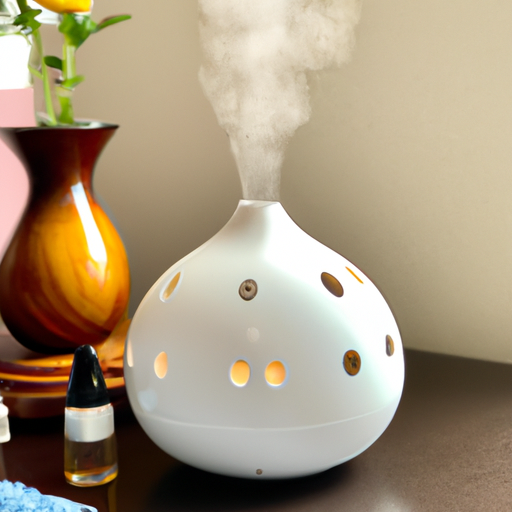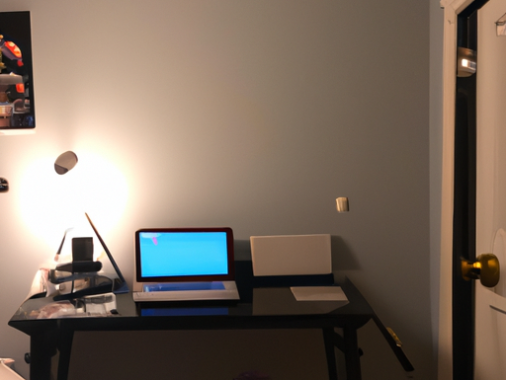-
Table of Contents
- Introduction
- How to Use an Oil Diffuser to Create a Relaxing Atmosphere
- The Benefits of Using an Oil Diffuser for Aromatherapy
- Essential Oil Blends for Your Oil Diffuser
- How to Clean and Maintain Your Oil Diffuser
- The Different Types of Oil Diffusers and Which is Best for You
- The Science Behind How an Oil Diffuser Works
- How to Choose the Right Oil Diffuser for Your Home
- Q&A
- Conclusion
Introduction
An oil diffuser is a device that disperses essential oils into the air. It is used to create a pleasant aroma in a room, as well as to provide therapeutic benefits. The diffuser works by breaking down the essential oils into tiny particles, which are then released into the air. This allows the oils to be inhaled, providing a range of benefits such as relaxation, improved mood, and improved sleep. In addition, the diffuser can also help to purify the air, removing dust, bacteria, and other allergens.
How to Use an Oil Diffuser to Create a Relaxing Atmosphere
Using an oil diffuser is an effective way to create a relaxing atmosphere in any room. An oil diffuser is a device that disperses essential oils into the air, allowing you to enjoy the therapeutic benefits of aromatherapy. Here are some tips for using an oil diffuser to create a calming atmosphere:
1. Choose the right essential oils. Different essential oils have different properties, so it’s important to choose the right ones for your needs. Lavender, chamomile, and ylang-ylang are all great choices for relaxation.
2. Set the mood. Before you start diffusing, make sure the room is comfortable and inviting. Dim the lights, light some candles, and play some soothing music.
3. Start diffusing. Fill the diffuser with water and add a few drops of your chosen essential oils. Turn it on and let it run for at least 30 minutes.
4. Enjoy the atmosphere. Sit back and relax as the essential oils fill the room with their calming scent.
Using an oil diffuser is an easy and effective way to create a relaxing atmosphere in any room. With the right essential oils and a few simple steps, you can enjoy the therapeutic benefits of aromatherapy in the comfort of your own home.
The Benefits of Using an Oil Diffuser for Aromatherapy
Aromatherapy is a holistic healing treatment that uses natural plant extracts to promote health and well-being. One of the most popular methods of aromatherapy is the use of an oil diffuser. An oil diffuser is a device that disperses essential oils into the air, allowing the user to enjoy the therapeutic benefits of the oils.
Using an oil diffuser for aromatherapy has many benefits. First, it is a safe and effective way to enjoy the therapeutic benefits of essential oils. Diffusers allow the user to enjoy the therapeutic benefits of essential oils without having to worry about the potential risks associated with direct contact with the oils. Additionally, diffusers are easy to use and require minimal maintenance.
Another benefit of using an oil diffuser for aromatherapy is that it can help to create a calming and relaxing atmosphere. The scent of essential oils can help to reduce stress and anxiety, as well as promote relaxation. Diffusers can also help to improve air quality by eliminating odors and purifying the air.
Finally, using an oil diffuser for aromatherapy can be an economical way to enjoy the therapeutic benefits of essential oils. Diffusers are relatively inexpensive and can be used for a long period of time. Additionally, essential oils are relatively inexpensive and can be used for multiple applications.
In conclusion, using an oil diffuser for aromatherapy is a safe and effective way to enjoy the therapeutic benefits of essential oils. Diffusers are easy to use and require minimal maintenance, and they can help to create a calming and relaxing atmosphere. Additionally, using an oil diffuser for aromatherapy is an economical way to enjoy the therapeutic benefits of essential oils.
Essential Oil Blends for Your Oil Diffuser
1. Uplifting Blend: This blend of essential oils is perfect for creating a positive and energizing atmosphere. Combine 5 drops of lemon, 4 drops of grapefruit, and 3 drops of peppermint essential oils in your oil diffuser.
2. Relaxing Blend: This blend of essential oils is perfect for creating a calming and soothing atmosphere. Combine 4 drops of lavender, 3 drops of chamomile, and 3 drops of ylang ylang essential oils in your oil diffuser.
3. Purifying Blend: This blend of essential oils is perfect for purifying the air and creating a fresh atmosphere. Combine 5 drops of tea tree, 4 drops of eucalyptus, and 3 drops of rosemary essential oils in your oil diffuser.
4. Invigorating Blend: This blend of essential oils is perfect for creating an invigorating and stimulating atmosphere. Combine 5 drops of orange, 4 drops of bergamot, and 3 drops of rosemary essential oils in your oil diffuser.
5. Refreshing Blend: This blend of essential oils is perfect for creating a refreshing and revitalizing atmosphere. Combine 5 drops of lemon, 4 drops of peppermint, and 3 drops of eucalyptus essential oils in your oil diffuser.
How to Clean and Maintain Your Oil Diffuser
Maintaining your oil diffuser is essential for ensuring it works properly and lasts for a long time. Here are some tips on how to clean and maintain your oil diffuser.
1. Empty the water tank: Before cleaning your oil diffuser, make sure to empty the water tank. This will help prevent any water from getting into the electrical components of the diffuser.
2. Clean the water tank: After emptying the water tank, use a mild soap and warm water to clean the tank. Make sure to rinse it thoroughly and dry it completely before refilling it.
3. Clean the diffuser: Use a damp cloth to wipe down the outside of the diffuser. Make sure to avoid getting any water into the electrical components.
4. Change the water regularly: It is important to change the water in your diffuser regularly. This will help prevent bacteria and mold from growing in the water tank.
5. Use the right oils: Make sure to use only high-quality essential oils in your diffuser. Low-quality oils can damage the diffuser and reduce its effectiveness.
6. Clean the air filter: If your diffuser has an air filter, make sure to clean it regularly. This will help keep the air in your home clean and free of dust and allergens.
By following these tips, you can ensure that your oil diffuser is clean and working properly. Regular maintenance and cleaning will help extend the life of your diffuser and keep it working efficiently.
The Different Types of Oil Diffusers and Which is Best for You
Oil diffusers are a great way to enjoy the therapeutic benefits of essential oils. They come in a variety of shapes, sizes, and styles, so it can be difficult to decide which type is best for you. To help you make an informed decision, here is a breakdown of the different types of oil diffusers and their benefits.
Ultrasonic Diffusers: Ultrasonic diffusers use ultrasonic vibrations to disperse essential oils into the air. They are relatively quiet and require no heat, making them a great choice for those who want to enjoy the benefits of essential oils without the noise or heat of other diffusers.
Nebulizing Diffusers: Nebulizing diffusers use a high-pressure air stream to break down essential oils into tiny particles, which are then dispersed into the air. This type of diffuser is great for those who want to enjoy the full therapeutic benefits of essential oils, as it does not require any heat or water.
Evaporative Diffusers: Evaporative diffusers use a fan to blow air through a pad or filter that has been saturated with essential oils. This type of diffuser is great for those who want to enjoy the scent of essential oils without the need for heat or water.
Heat Diffusers: Heat diffusers use heat to disperse essential oils into the air. This type of diffuser is great for those who want to enjoy the therapeutic benefits of essential oils, as the heat helps to release the oils’ active ingredients. However, it is important to note that heat diffusers can be dangerous if used improperly.
When deciding which type of oil diffuser is best for you, it is important to consider your needs and preferences. Ultrasonic diffusers are great for those who want to enjoy the benefits of essential oils without the noise or heat of other diffusers. Nebulizing diffusers are great for those who want to enjoy the full therapeutic benefits of essential oils. Evaporative diffusers are great for those who want to enjoy the scent of essential oils without the need for heat or water. And heat diffusers are great for those who want to enjoy the therapeutic benefits of essential oils, but should be used with caution.
The Science Behind How an Oil Diffuser Works
An oil diffuser is a device that disperses essential oils into the air. It works by breaking down the essential oils into tiny molecules, which are then released into the air. This process is known as diffusion.
The science behind how an oil diffuser works is based on the principles of diffusion. Diffusion is the process by which molecules move from an area of higher concentration to an area of lower concentration. This is known as the diffusion gradient. In the case of an oil diffuser, the essential oils are placed in a container with a fan or other device that creates a flow of air. The essential oils are then broken down into tiny molecules, which are then dispersed into the air.
The diffusion process is further enhanced by the use of ultrasonic technology. Ultrasonic technology uses sound waves to create vibrations that break down the essential oils into even smaller molecules. This allows for a more efficient diffusion process, as the molecules are able to travel further and faster.
The diffusion process is also aided by the use of a carrier oil. Carrier oils are used to dilute the essential oils, making them easier to disperse into the air. The carrier oil also helps to keep the essential oils from evaporating too quickly, allowing them to remain in the air for a longer period of time.
The diffusion process is also aided by the use of a diffuser base. The diffuser base is a material that helps to absorb the essential oils and disperse them into the air. Common diffuser bases include ceramic, glass, and metal.
The diffusion process is also aided by the use of a wick. The wick helps to draw the essential oils up from the container and disperse them into the air. The wick also helps to keep the essential oils from evaporating too quickly.
The diffusion process is also aided by the use of a fan. The fan helps to create a flow of air, which helps to disperse the essential oils into the air.
The diffusion process is also aided by the use of a timer. The timer helps to regulate the amount of time that the essential oils are dispersed into the air. This helps to ensure that the essential oils are not over-diffused, which can lead to an unpleasant smell.
The diffusion process is also aided by the use of a filter. The filter helps to remove any impurities from the essential oils, ensuring that only the purest essential oils are dispersed into the air.
The diffusion process is also aided by the use of a humidifier. The humidifier helps to keep the air moist, which helps to keep the essential oils from evaporating too quickly.
The diffusion process is also aided by the use of a diffuser cover. The diffuser cover helps to keep the essential oils from evaporating too quickly, as well as helping to keep dust and other particles from entering the diffuser.
The diffusion process is also aided by the use of a diffuser stand. The diffuser stand helps to keep the diffuser in an upright position, ensuring that the essential oils are dispersed evenly into the air.
The diffusion process is also aided by the use of a diffuser light. The diffuser light helps to create a calming atmosphere, as well as helping to keep the essential oils from evaporating too quickly.
The diffusion process is also aided by the use of a diffuser scent. The diffuser scent helps to
How to Choose the Right Oil Diffuser for Your Home
When it comes to creating a pleasant and inviting atmosphere in your home, an oil diffuser can be a great addition. Not only do they provide a pleasant scent, but they can also help to reduce stress and improve your overall wellbeing. However, with so many different types of oil diffusers available, it can be difficult to know which one is right for you. Here are some tips to help you choose the right oil diffuser for your home.
First, consider the size of the room you want to use the diffuser in. If you’re looking for a diffuser for a large room, you’ll want to choose one with a larger capacity. On the other hand, if you’re looking for a diffuser for a smaller space, you’ll want to opt for a smaller model.
Next, think about the type of scent you want to create. Some diffusers are designed to disperse a single scent, while others are designed to disperse multiple scents. If you’re looking for a diffuser that can disperse multiple scents, you’ll want to look for one with a larger capacity.
Finally, consider the type of diffuser you want. There are several different types of diffusers available, including ultrasonic, nebulizing, and heat diffusers. Each type has its own advantages and disadvantages, so it’s important to do your research and decide which type is best for your needs.
By taking the time to consider these factors, you can ensure that you choose the right oil diffuser for your home. With the right diffuser, you can create a pleasant and inviting atmosphere in your home that will help to reduce stress and improve your overall wellbeing.
Q&A
1. What is an oil diffuser?
An oil diffuser is a device that disperses essential oils into the air. It works by using ultrasonic vibrations to break down the essential oils into tiny particles, which are then released into the air.
2. What are the benefits of using an oil diffuser?
Using an oil diffuser can help to improve air quality, reduce stress, and promote relaxation. It can also help to reduce symptoms of allergies, colds, and other respiratory illnesses.
3. How do I use an oil diffuser?
To use an oil diffuser, simply add a few drops of your favorite essential oil to the diffuser, fill it with water, and turn it on. The diffuser will then disperse the essential oil into the air.
4. How often should I use an oil diffuser?
It is recommended to use an oil diffuser for 15-30 minutes at a time, several times a day.
5. Are there any safety precautions I should take when using an oil diffuser?
Yes, it is important to keep the diffuser away from children and pets, and to make sure that the diffuser is placed in a well-ventilated area. Additionally, it is important to read the instructions that come with the diffuser before using it.
6. What types of essential oils can I use in an oil diffuser?
Most essential oils can be used in an oil diffuser, including lavender, eucalyptus, peppermint, and tea tree oil.
7. How do I clean an oil diffuser?
To clean an oil diffuser, simply fill it with warm water and a few drops of white vinegar. Let the mixture sit for a few minutes, then empty the diffuser and rinse it with clean water.
Conclusion
An oil diffuser is a great way to enjoy the benefits of essential oils in your home or office. It can help to improve air quality, reduce stress, and create a calming atmosphere. With its many benefits, an oil diffuser is an excellent addition to any home or office.




